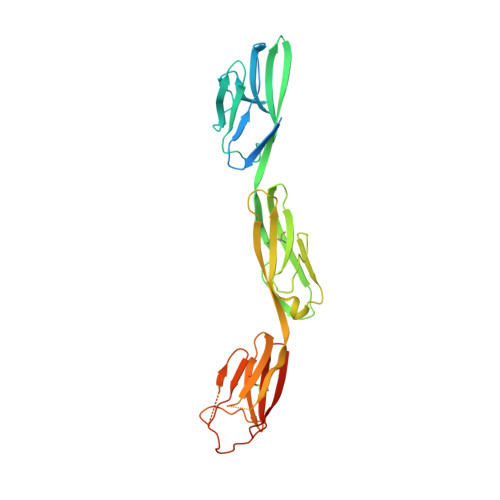Highly Conserved Molecular Features in IgLONs Contrast Their Distinct Structural and Biological Outcomes.
Venkannagari, H., Kasper, J.M., Misra, A., Rush, S.A., Fan, S., Lee, H., Sun, H., Seshadrinathan, S., Machius, M., Hommel, J.D., Rudenko, G.(2020) J Mol Biol 432: 5287-5303
- PubMed: 32710982
- DOI: https://doi.org/10.1016/j.jmb.2020.07.014
- Primary Citation of Related Structures:
6U6T, 6U7N - PubMed Abstract:
Neuronal growth regulator 1 (NEGR1) and neurotrimin (NTM) are abundant cell-surface proteins found in the brain and form part of the IgLON (Immunoglobulin LSAMP, OBCAM, Neurotrimin) family. In humans, NEGR1 is implicated in obesity and mental disorders, while NTM is linked to intelligence and cognitive function. IgLONs dimerize homophilically and heterophilically, and they are thought to shape synaptic connections and neural circuits by acting in trans (spanning cellular junctions) and/or in cis (at the same side of a junction). Here, we reveal homodimeric structures of NEGR1 and NTM. They assemble into V-shaped complexes via their Ig1 domains, and disruption of the Ig1-Ig1 interface abolishes dimerization in solution. A hydrophobic ridge from one Ig1 domain inserts into a hydrophobic pocket from the opposing Ig1 domain producing an interaction interface that is highly conserved among IgLONs but remarkably plastic structurally. Given the high degree of sequence conservation at the interaction interface, we tested whether different IgLONs could elicit the same biological effect in vivo. In a small-scale study administering different soluble IgLONs directly into the brain and monitoring feeding, only NEGR1 altered food intake significantly. Taking NEGR1 as a prototype, our studies thus indicate that while IgLONs share a conserved mode of interaction and are able to bind each other as homomers and heteromers, they are structurally plastic and can exert unique biological action.
Organizational Affiliation:
Department of Pharmacology and Toxicology, University of Texas Medical Branch, Galveston, TX 77555, USA; Sealy Center for Structural Biology and Molecular Biophysics, University of Texas Medical Branch, Galveston, TX 77555, USA.


















